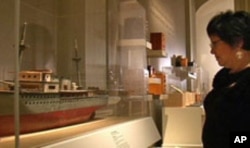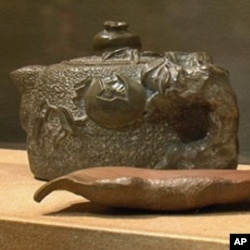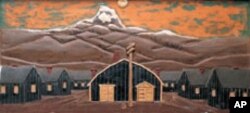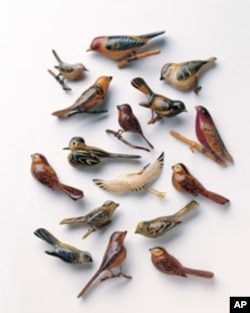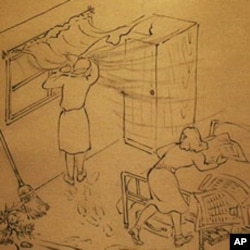An exhibition of art created by Japanese-Americans draws attention to one of the U.S. government's most controversial acts.
The more than 100 works collected for "The Art of Gaman" exhibit in Washington, D.C., were created by men and women who were removed from their homes and imprisoned in federally-run camps during World War II.
Quest for objects begins with a pin
Carved walking sticks, small wooden chests, paintings of the simple wood-frame barracks that served as home for three years, a toy train, dolls, baskets, and dozens of pins made of shells or carved from wood are among the objects on display at the Smithsonian's Renwick Gallery.
Curator Delphine Hirasuna says "The Art of Gaman" was launched when she discovered a small wooden pin carved in the shape of a bird.
"After my mom died, I was going through a box in the garage. When I looked inside, I saw this little bird pin." One day when she was wearing it, a friend asked her about it, and she told him she thought it was made in camp. "And he said, 'I wonder what else is out there?' And that is what started me on this quest."
Hirasuna says her parents didn't talk about camp much when she was growing up. "I was always aware that there was something, but they never sat down and explained what happened and their reaction to it."
Overreaction to Pearl Harbor
Hirasuna's parents were among the 120,000 men, women and children who were rounded up, evacuated from their homes and sent to one of 10 isolated relocation sites built to house Japanese-Americans during the country's bloody three-year war with Japan in World War II.
In February 1942, two months after Japan bombed the large U.S. naval base at Pearl Harbor, Hawaii, President Franklin Roosevelt signed an executive order directing the roundup. Like Hirasuna's parents, two-thirds of the internees were native-born American citizens.
"Because Pearl Harbor had been attacked, they were nervous about an attack on the West Coast, but there was an overreaction," she says. "If you were living on the West Coast and you had 1/16 Japanese blood, you had to go to camp."
The government documented the evacuation and camp life with film and photographs. So did some of the evacuees. In fact, says Hirasuna, they were some of the first to do so.
Chiura Obata, an art professor at University of California — Berkeley, "started sketching a diary from the time he left his house in Berkeley. So you see his suitcase by the door, and then you see a sketch arriving at the church, which was an assembly point to be taken into camp."
Mine Okubo did sketches of camp life as well, and managed to have some of her drawings published in 1946 as a graphic novel titled, "Citizen 13660." Hirasuna says Okubo's images are often humorous. "I don't know whether she did that to not alarm the authorities, to get it published or because she just had a sense of humor."
A way to "Gaman"
But most of the art in the exhibition was not created by professional artists, and initially, Hirasuna says, it was created by necessity. "Because the only thing that was in their barrack was a metal cot and mattress ticking which they filled with straw, the first things they made were chairs, tables, someplace to put their clothes away."
Later, because they remained in camp for more than three years, they began to make decorative objects. And they made them using found materials; weaving baskets from waxed tissue paper and making jewelry from seashells.
"Two of the camps were (located) over ancient sea beds," Hirasuna says. "They discovered that there were millions of shells on the ground. You could just scratch the earth and pick up buckets." One camp had an abandoned slate quarry, where people picked up slate to carve into teapots.
Most of the artists were Issei, the elder generation who had emigrated from Japan prior to 1924, when the United States passed a law curtailing Japanese immigration. The younger generation was busy with school, sports and community activities. Some left the camp for jobs in the east or even joined the army. Hirasuna says, "What happened was the first generation got left in the camps and this was their way of keeping busy."
It was also their way to achieve "Gaman," an expression Hirasuna heard repeatedly when she was looking for objects for her book and which inspired its title. "Gaman actually means to bear the seemingly unbearable with patience and dignity."
"The old folks would say in Japanese to me, 'Our future is unknown. This is very, very trying,'" recalls Jim Yamaichi, who was 19 when his family was interned.
He says his father dealt with the stress by taking up woodcarving. "I never knew he that could do anything like that and he was fantastic. But after coming back, that was the end of the line. The farm, his livelihood was the most important thing."
Hirasuna says that was true of most of the artists in the exhibition, "because times were tough. Basically you lost everything and had to start over. They didn't have time to pursue any pastime like art."
And, she says, for the most part, the things created in camp were forgotten about. Many were even lost.
"I think they probably at some level were proud of what they did and brought it back," the curator says, "but for every object I heard about, I heard of 10 more that were thrown away."
But Jewel Okawachi kept the shell jewelry, bird pins, carved walking sticks and other objects her parents accumulated over the years in camp. She says they were given to her father, who had been a dentist in San Francisco.
"In camp, he opened a little dental lab in part of our barrack and started making dentures for internees. I think they appreciated what he did so they gave him all of these art objects," says Okawachi.
Welcome tribute
Although she knows nothing about the artists who created the objects, Okawachi assumes they would be pleased to learn their work is on display in the Smithsonian's prestigious Renwick Gallery. For Okawachi, "The Art of Gaman" is a welcome tribute to her parents.
"The only time I feel bitter is [when I think of] what it [internment] did to my parents," she says. "They came to this country for freedom and to make a better life for themselves and this happened." She says people often asked her father why he never became a U.S. citizen, not realizing the law prevented him from doing so until 1952.
"Having your freedom taken away from you is hard to forget," she says. "I hope it never happens to anyone else."
No one of Japanese ancestry in the United States was ever found guilty of sabotage or treason during World War II. Yet it took more than 40 years after their release in 1945 for the U.S. government to issue an apology and offer financial restitution for their lost property and their lost freedom — a check for $20,000 to each surviving internee.





